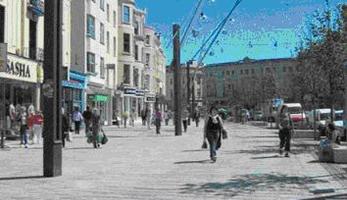Restricting car access to Cork city centre
Thematic areas
Demand & urban space management
Summary
Sustainable urban mobility was promoted in Cork by restricting vehicle access and redesigning St Patrick’s Street in the heart of the city. Pavements were widened and new bicycle and pedestrian facilities were created in order to make the city centre environment safer and healthier.
Implementing sustainable mobility
In the early 1990s, it became increasingly apparent that the pavements of Cork’s primary shopping street, St. Patrick’s Street, needed extensive repair and widening as they were no longer sufficient to comfortably and safely accommodate the high volumes of pedestrians in the city centre. Preliminary designs were made, but matters became more urgent when the Cork Main Drainage Project in 1998 required the street to be dug up in order to lay a drainage network. Cork City Council decided to incorporate measures into the redesign of St. Patrick’s Street that would further encourage more sustainable transport through the city.
When calculating the optimum dimensions of the street, the architects adopted the latest thinking on urban traffic consistent with the Traffic Assessment Framework (part of the Historic Centre Action Plan). Accordingly, traffic lane dimensions were determined on the basis of the desirable number of vehicles passing through the historic centre, rather than in terms of the greatest possible number of vehicles that can pass through.
The objectives were to:
- provide a safer, healthier, more comfortable environment for pedestrians and cyclists in the city centre by providing more seating/resting areas and wider pedestrian crossings with audible signals that are easier for people with mobility difficulties to use;
- reduce lane capacity by 50 percent (from four to two) on the city’s main arterial route, which cuts through the heart of the city’s primary shopping district;
- redirect motor traffic away from the city centre and onto the ring roads or into the park and ride centres;
- widen the pavements to accommodate at least 40 percent more cycle parking facilities within the city centre;
- install textured paving for visually impaired people to guide them along the street towards crossings;
- remove on-street parking from St. Patrick’s Street and redirect access to nearby multi-storey car parks via alternative routes;
- increase public awareness of the need, potential and ability to change to more sustainable transport patterns;
- promote access to the city centre by public transport, as a viable alternative to the private car; and
- reduce traffic levels through the access-restricted zone by at least 2 percent, as compared with the “do nothing” scenario.
Progress
In 1999, a design was drawn up by Beth Galí Studios to transform St. Patrick’s Street into a more pedestrian friendly, aesthetically appealing public space. With the aid of funds from the CIVITAS initiative, the design was further refined to incorporate specific CIVITAS-funded features such as the provision of access restriction bollards with audible and visual warning devices.
The design of alternative routing to accommodate the future access restrictions around St. Patrick’s Street commenced following the application for CIVITAS funding in July 2001. As a result, a two-way system along the quays was introduced in October 2001 to facilitate the creation of the city centre clean zone.
Outcomes
The new-look pedestrian friendlier streetscape was officially opened with a special ceremony on European Car Free Day in September 2004.
Following the success of the measure, it was decided to pedestrianise adjacent streets, forming a city centre clean zone of three streets where access by private vehicles powered by fossil fuels would be restricted during the day.
This fact sheet has been updated by a third party on the basis of available information (not by the city itself), therefore we do not guarantee any data with respect to their content, completeness or up-to-dateness.







